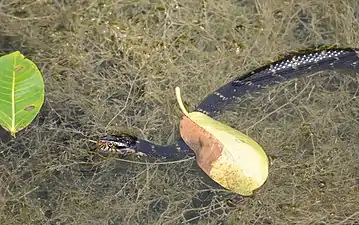| Florida banded water snake | |
|---|---|
 | |
| Florida banded water snake in defensive posture | |
| Scientific classification | |
| Domain: | Eukaryota |
| Kingdom: | Animalia |
| Phylum: | Chordata |
| Class: | Reptilia |
| Order: | Squamata |
| Suborder: | Serpentes |
| Family: | Colubridae |
| Genus: | Nerodia |
| Species: | |
| Subspecies: | N. f. pictiventris |
| Trinomial name | |
| Nerodia fasciata pictiventris (Cope, 1895) | |
| Synonyms | |
| |
The Florida banded water snake (Nerodia fasciata pictiventris), a subspecies of the banded water snake (southern water snake - Nerodia fasciata), is a nonvenomous natricine colubrid native to the southeastern United States.
Geographic range
The Florida banded water snake is endemic throughout Florida, South Carolina, southwestern and southeastern North Augusta, Beech Island, South West of Aiken County including areas running alongside Savannah River, Northern Georgia. In addition, it has been introduced to Brownsville, Texas. It has also established populations in Folsom[2] and Harbor City, California.[3]
Description
Dorsally, it is light brown or yellowish, with 26–35 reddish-brown to black crossbands. Ventrally, it is yellow or white, with reddish-brown or black markings. In large adult individuals, the ground color on the lower sides is sometimes darker than the crossbands, producing an appearance of alternating blotches on the back and sides.
The Florida water snake differs from the southern water snake (N. f. fasciata) chiefly in the shape of the markings on the ventrals. In N. f.pictiventris, these markings consist of transverse blotches, many of them enclosing an oval white spot, whereas in N. f. fasciata, they are solid, squarish spots.[4]
Adults average 24 to 42 in (61 to 107 cm) in total length.
Reproduction
They are ovoviviparous. Mating occurs from March to May, and the young are born from May to August, in broods of 25–57. The newborns are 180–223 mm (7.0–8.8 inches) in total length.[5]
Gallery
 Florida Water Snake in Avila, Tampa, Florida
Florida Water Snake in Avila, Tampa, Florida Florida Banded Water Snake Green Cay Wetlands, Florida
Florida Banded Water Snake Green Cay Wetlands, Florida
Notes
- ↑ NatureServe (4 August 2023). "Nerodia fasciata pictiventris". NatureServe Network Biodiversity Location Data accessed through NatureServe Explorer. Arlington, Virginia: NatureServe. Retrieved 5 August 2023.
- ↑ Balfour et al. 2007.
- ↑ Fuller and Trevett. 2006.
- ↑ Schmidt, K.P., and D.D. Davis. 1941. Fieldbook of Snakes of the United States and Canada. G.P. Putnam's Sons. New York. 365 pp. (Natrix sipedon pictiventris, pp. 221-222, Figure 72.)
- ↑ Wright, A.H., and A.A. Wright. 1957. Handbook of Snakes of the United States and Canada. Comstock. Ithaca and London. 1,105 pp. (in 2 volumes) (Natrix sipedon pictiventris, pp. 535-538, Figure 159. + Map 42. on p. 512.)
References
- Balfour, P.S., E.W. Stitt, M.M. Fuller, and T. K. Luckan. 2007. Nerodia fasciata pictiventris (Florida water snake). Herpetological Review 38:489.
- Cope, E.D. 1895. On some new North American Snakes. American Naturalist 29: 676–689. (Natrix fasciata pictiventris, pp. 677–678.)
- Fuller, M.M. and B.W. Trevett. 2006. Nerodia fasciata pictiventris (Florida water snake). Herpetological Review 37:363.
